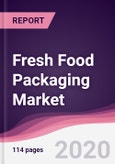What is Fresh Food Packaging Market?
Fresh Food Packaging involves in providing protection, safety and it also gives great resistance power to defend from pathogens, bacteria and microorganisms. The food enclosed in the package may need to safeguard from other things like shock, vibration, compression, temperature, bacteria.
Driven by growing sophistication, buyers in these markets are increasingly health conscious and are gradually becoming more accustomed to reading the nutritional information labels which are printed on all packaged food packaging. Major packing materials such as paper, plastic, glass and metal manufacturers are ensuring not to affect the quality of food to remain competitive by producing healthy and convenient products.
This report incorporates an in-depth assessment of Fresh Food Packaging Market by technology, type, thickness, products, end user industries and geography.
What are the major applications for Fresh Food Packaging?
The various end users assessed includes Sea Food, Meat, Vegetables, Fruits, Baby Nutrition, Baked Goods, Cooking Aids & Spreads, Ready Meals, Bars, Biscuits & Cereals, Crisp, Snacks & Nuts, Diary & Ice Cream, Confectionery and Others. Vegetables and fruits are the dominant end users in generating global market revenue. Materials are sustainable and environmentally friendly packaging along with high performance and lower cost. As long as the product travels for longer distance it has to maintain the optimum level protection for more durability. Balancing all social, economic and environmental factors makes the market to lead in future.
Fresh Food Packaging Market
Market Research and Market Trends of Fresh Food Packaging Market
- Real-Time Monitoring System: Consuming the expired food may lead to serious health problems so a real-time monitoring system which helps to detect food freshness whereas it is safe, hygienic, inexpensive, and highly accurate where consumers can choose food packages with the best quality. This detection is done using a small smart sensor tag that consists of three ultra-low power consumption sensors. The freshness is monitored and assessed by various factors including temperature, humidity, as well as the gas concentration of ammonia and hydrogen sulphide.
- Remote LED Lighting Technology: Currently it is developed in two main configurations, LED visible light and UV LED light. The product has its main application in the context of processing and producing fresh and possibly organic food especially in fruits and vegetables. Those industries are facing several challenges regarding food illumination and using Ultraviolet (UV) light for sanitizing, disinfection or germicidal treatments both in food production lines and for the food itself directly or through tools.
- Nanotechnology: Nanotechnology, which represents the discipline of very small materials, is ready to play a major role in food manufacturing and packaging. Nanostructured materials are used as oxygen hunters, antimicrobial thin films, and gas-permeable composites. At the same time, nano composite films may be employed for the purpose of removing dirty air, for example, carbon dioxide from the package. The freshness of food can be observed or shown by people, during the course of its storing or conveyance.
- Biosensors and Chemical Sensors: Innovative sensors ensure the safety and quality of food from the manufacturers to the buyers. This trend gives rise to different sensor designs which enhances the food safety by quality check such as pathogens, freshness, carbon dioxide, leakage, oxygen, pH, temperature and time. Controlling the quality and safety in terms of buyers, superiors and food producers has great capability in the development of new sensing systems mixed in the food packaging, which are beyond the existing traditional technologies like control of volume, weight, color and appearance.
- Smart Packaging System: The packaging is done in such a way that it detects pH changes and other indicators which provide the percentage of food spoilage. These indicators give relevant data about product quality by surrounding conditions and headspace gases of packages. They can be coupled with the package surface or merged to packages which are improved for determining metabolite residue formed during storage. Microbial spoilage, temperature, physical shock, package integrity, originality of the packaged product can be controlled.
Who are the Major Players in Fresh Food Packaging market?
The companies referred to in the market research report includes ACREO, AMCOR LIMITED, American Packaging Corporation, AMPACET CORPORATION, BASF SE, BEMIS COMPANY, INC., Blue Spark Technologies, Graham Packaging Industry, INNOVIA FILMS, ITC Limited, Jabil, Wageningen UR Food & Bio based Research, Wells Plastics Ltd and more than 20 companies.
What is our report scope?
The report incorporates in-depth assessment of the competitive landscape, product market sizing, product benchmarking, market trends, product developments, financial analysis, strategic analysis and so on to gauge the impact forces and potential opportunities of the market. Apart from this the report also includes a study of major developments in the market such as product launches, agreements, acquisitions, collaborations, mergers and so on to comprehend the prevailing market dynamics at present and its impact during the forecast period 2020-2025.
Key Takeaways from this Report
- Evaluate market potential through analyzing growth rates (CAGR %), Volume (Units) and Value ($M) data given at country level – for product types, end use applications and by different industry verticals.
- Understand the different dynamics influencing the market – key driving factors, challenges and hidden opportunities.
- Get in-depth insights on your competitor performance – market shares, strategies, financial benchmarking, product benchmarking, SWOT and more.
- Analyse the sales and distribution channels across key geographies to improve top-line revenues.
- Understand the industry supply chain with a deep-dive on the value augmentation at each step, in order to optimize value and bring efficiencies in your processes.
- Get a quick outlook on the market entropy – M&A’s, deals, partnerships, product launches of all key players for the past 4 years.
- Evaluate the supply-demand gaps, import-export statistics and regulatory landscape for more than top 20 countries globally for the market.
Table of Contents
Methodology

LOADING...








